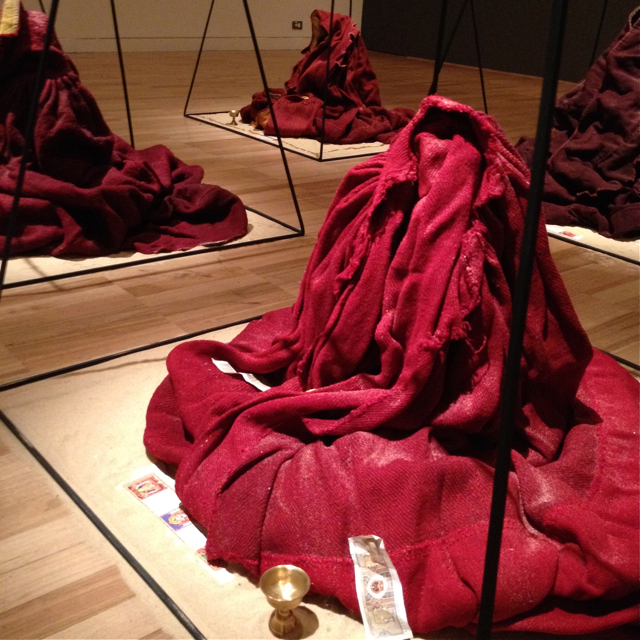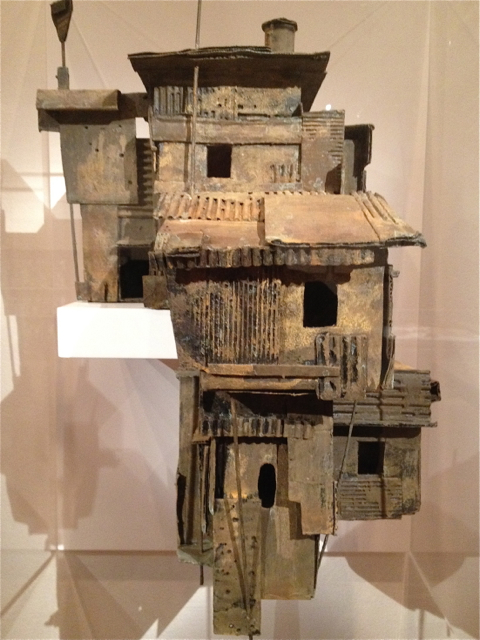In the entrance foyer to the Gallery was a forest of embroidery and quilting hoops of various sizes encasing embroideries of Chinese characters - with their threads still hanging from the subtly coloured characters.


The work is by contemporary Chinese artist Lin Tianmiao and we discovered, by reading the accompanying explanatory description, that the characters were new words that describe women and their roles, made common by social media . Though many of the terms are somewhat derogatory, eg 'husband hunter','gap-toothed beauty', the overall emphasis is on women's agency in modern Chinese life. I liked the use of a traditional women's craft, embroidery, to portray women's roles as depicted through modern technology. Neat. And, as always, I was attracted by the tactile element that comes with the use of textiles. Despite signs warning the work was not to be touched, I noticed many people absently trailing their hands through the hanging threads as they passed by the work. We discovered this work was part of a larger exhibition called 'Go East' and so decided to see the other works in this exhibition.
In Australia we often bemoan the lack of patrons of the arts, so it was a pleasure to discover that this group of modern Asian works was drawn from the private collection of Gene and Brian Sherman. Our galleries don't have the treasures of Western art that one sees in Europe and the USA, but I think as a compensation we in Australia have frequent access to modern Asian art that is well-informed and well-curated.
I thought one of the most moving works in the 'Go East' exhibition was 'Zen Meditation' by Tibetan artist Nortse - a collection of six charred monks' robes arranged in frames.


My immediate response was to the deep, rich colours and tactile quality of the roughly woven robes, but it takes only a few moments to be reminded of the many Tibetan monks who have self-immolated in their resistance to the domination of Tibet by China. The Chinese currency in the frames is another reference to the economic intrusion and consumerism with which modern Tibet is confronted. The characteristic I find very interesting about modern Asian art is its engagement with the politics and culture of the day. Sometimes, as with the Tibetan robes, the political message is obvious. At other times, such as with the work below, 'There is no voice...', it is more subtle.

In a collaboration with the older people of the Chiang Mai community, Thai artist Navin Rawanchaikul has constructed an artwork that's a collection of various sized old medicine bottles that have photographs inserted within them. The bottles are crowded into shelves in a simply crafted display case. The older people in the photos are dressed in everyday traditional work clothes and some of the bottles are crazed and clouded. A way of life is fading and disappearing.
'Habitation' is a group of shanty structures built from Ikea packaging and precariously balanced above and below shelves. So many ideas... the need to scavenge to survive; the precariousness, both literal and metaphorical, of a way of life; the creativity of recycling:

The creators of these delightful structures are Filipino artists Alfredo Juan Aquilizan and Maria Isabel Guardinez Aquilizan. Their names tugged at my memory - I was sure I'd encountered them before and so I trawled through my blog to discover that I'd written about them five and a half years ago when my grand-daughter and I had participated in one of their interactive works at the Queensland Art Gallery. Sometimes blogging has its uses!
There were, of course, lots of other wonderful works. Lots to be delighted by and confronted by (eg some very lifelike furless silicon rats that seemed to breathe!) I always forget that viewing artworks makes me perceive and interpret the world using quite different processes from those I use in everyday life, or even when I'm reading or viewing films. It's always good to be jolted into a realisation that there are other ways of seeing.